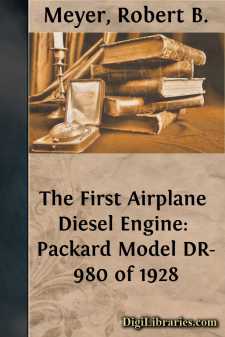Categories
- Antiques & Collectibles 13
- Architecture 36
- Art 48
- Bibles 22
- Biography & Autobiography 813
- Body, Mind & Spirit 142
- Business & Economics 28
- Children's Books 14
- Children's Fiction 11
- Computers 4
- Cooking 94
- Crafts & Hobbies 4
- Drama 346
- Education 46
- Family & Relationships 57
- Fiction 11828
- Games 19
- Gardening 17
- Health & Fitness 34
- History 1377
- House & Home 1
- Humor 147
- Juvenile Fiction 1873
- Juvenile Nonfiction 202
- Language Arts & Disciplines 88
- Law 16
- Literary Collections 686
- Literary Criticism 179
- Mathematics 13
- Medical 41
- Music 40
- Nature 179
- Non-Classifiable 1768
- Performing Arts 7
- Periodicals 1453
- Philosophy 64
- Photography 2
- Poetry 896
- Political Science 203
- Psychology 42
- Reference 154
- Religion 513
- Science 126
- Self-Help 84
- Social Science 81
- Sports & Recreation 34
- Study Aids 3
- Technology & Engineering 59
- Transportation 23
- Travel 463
- True Crime 29
The First Airplane Diesel Engine: Packard Model DR-980 of 1928
by: Robert B. Meyer
Description:
Excerpt
It is difficult to acknowledge fully the assistance given by persons and museums for the preparation of this book. However, I wish especially to thank Hugo T. Byttebier, engine historian, Buenos Aires, Argentina; Dipl. Ing. Hermann I. A. Dorner, diesel designer, Hanover, Germany; Harold E. Morehouse, and C. H. Wiegman, Lycoming Engines, Williamsport, Pennsylvania; Barry Tully, Goodyear Aircraft, Akron, Ohio; Richard S. Allen, aviation author, Round Lake, New York; William H. Cramer, brother of Parker D. Cramer, Wantagh, New York; Erik Hildes-Heim, Early Bird and aviation historian, Fairfield, Connecticut.
I am particularly grateful to curators of the following museums who have been so generous in their assistance: Deutsches Museum, Munich, Germany (Dipl. Ing. W. Jackle); Henry Ford Museum, Dearborn, Michigan (Leslie, R. Henry); U.S. Air Force Museum, Wright-Patterson Air Force Base, Dayton, Ohio (Maj. Robert L. Bryant, Jr., director); Science Museum, London, England (Lt. Comdr. (E) W. J. Tuck, Royal Navy). The preparation of this paper could not have been accomplished without the aid of the National Air Museum of the Smithsonian Institution and the help of Philip S. Hopkins, director, and Paul E. Garber, head curator and historian.
Foreword
In this second number of the Smithsonian Annals of Flight, Robert B. Meyer Jr., curator and head of the flight propulsion division, tells the story of the first oil-burning engine to power an airplane, the Packard diesel engine of 1928, now in the collections of the National Air Museum.
The author’s narrative, well illustrated with drawings and photographs, provides a historical background for the development of the engine, and a technical description that includes specifications and details of performance. It also contains comments from men and women who flew planes powered by the Packard diesel. The author concludes with an analysis of the engine’s advantages and disadvantages.
Philip S. Hopkins
Director, National Air Museum
30 July 1964
On display in the National Air Museum, Smithsonian Institution, is the first oil-burning engine to power an airplane. Its label reads: “Packard Diesel Engine—1928—This first compression-ignition engine to power an airplane developed 225 hp at 1950 revolutions per minute. It was designed under the direction of L. M. Woolson. In 1931, a production example of this engine powered a Bellanca airplane to an 84 hour and 33 minute nonrefueled duration record which has never been equalled.—Weight/power ratio: 2.26 lb per hp—Gift of Packard Motor Car Co.”
Figure 1 (left).—Front view of first Packard diesel, 1928. Note hoop holding cylinders in place and absence of venturi throttles. This engine was equipped with an air pressure starting system. (Smithsonian photo A2388.)
Figure 2 (right).—Left side view of first Packard diesel, 1928. Heywood starter (air) fitting shown on the head of the next to lowest cylinder. (Smithsonian photo A2388C.)
This revolutionary engine was created in the short time of one year. Within two years of its introduction in 1928, airplane diesel engines were being tested in England by Rolls-Royce, in France by Panhard, in Germany by Junkers, in Italy by Fiat, and in the United States by Guiberson. Packard had demonstrated to the world the remarkable economy and safety of the airplane diesel engine, and the response was immediate and favorable. The novelty and performance of the Packard diesel assured it a large and attentive audience wherever it was exhibited. Yet in spite of its performance record the engine was doomed to failure by reason of its design, and it was further handicapped by having been rushed into production before it could be thoroughly tested.
History
The official beginning of the Packard diesel engine can be traced to a license agreement dated August 18, 1927, between Alvan Macauley, president of the Packard Motor Car Company of Detroit, Michigan, and Dipl....


